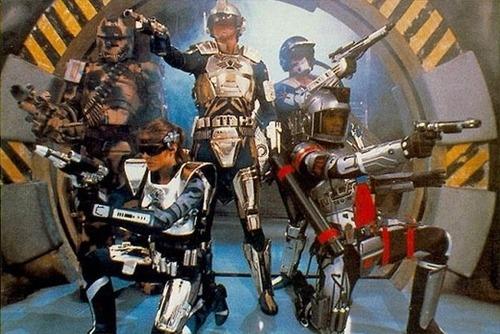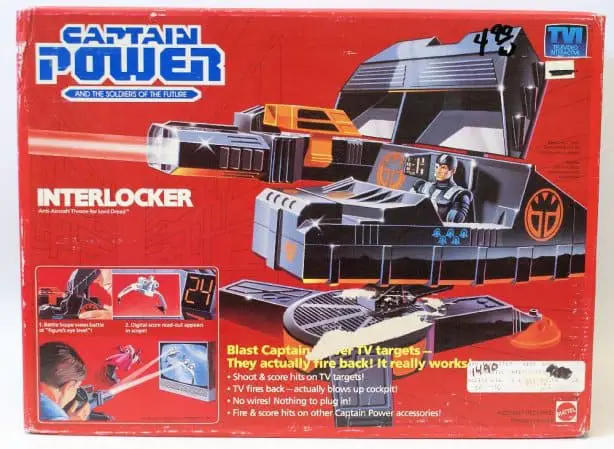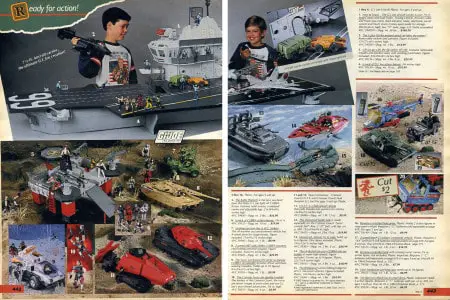
Everything today is interactive, maybe too interactive, but besides video games, the ‘80s had one show that was extremely groundbreaking
Captain Power was a 1987 science fiction/live action TV show that incorporated in computer-generated images. Toys were used that could interact with the show during certain segments by hitting sensors on the screen and being hit in return. It would only last one season.
I still think back on Captain Power and the Soldiers of the Future in complete awe. I remember the lead up to the TV show, I remember the commercials and I remember the toy. I didn’t own any of the stuff that could be used with the show.
But my best friend did.
Safe to say I was always at his house when Captain Power would be on to take part in this completely interactive viewing experience. I don’t know how interactive it really was but the fact that you were engaging with what was happening on the TV was mind-blowing to a kid in the ‘80s.
Captain Power was pretty ahead of its time and embraced technology in a way that captivated a lot of kids.
This is all about the story of Captain Power and the Soldiers of the Future.
What Was Captain Power?
Captain Power was a live action TV show from 1987 that was based around science fiction and action. It merged live action along with animation that was based on computer-generated images. Unlike Max Headroom they were using real computer-generated images.
The character was created by a guy named Gary Goddard who came up with the name before anything else. The name Captain Power seemed so simple and he was sure it had been used somewhere before. Turns out it hadn’t and he began to write out the characters and story.
Fun fact: Goddard was also involved in making He-Man which probably played a role in getting the toy and the show launched.
Captain Power would work alongside toys made by Mattel. Certain portions of the show would include visual and audio segments that interacted with the toys. You could shoot at the screen and the screen would shoot back at you. Sweet.
The interactive segments would last anywhere from 30 seconds to 3 minutes and you would use toys that were half gun half space ship. One such main toy would be the Powerjet XT-7. So this “toy” would serve as a weapon to fight with the show but then you could use it as a spaceship to play with during the other 23 hours and 30 minutes of the day.
The show debuted on September 30, 1987, and would only last one season made up of 22 episodes. Plans were made for a second season, with scripts written, but it was never seen through.
The Plot Of Captain Power
Captain Power is set on Earth in the 22nd century and was during a period of time that followed the “Metal Wars”. The Metal Wars was a revolt from the cyborgs that inhabited the Earth which would use artificial intelligence to take over the human race and rule them by intelligent machines.
Surviving humans live in hiding from the “Bio-Mechs” who will digitize the humans into virtual beings. This is all taking place in North America around the Great Lakes region.
It had kind of a RoboCop meets Blade Runner meets Wall-E vibe to it.
Captain Power is actually Jonathan Power and he leads a small group of guerilla warriors called “the Soldiers of the Future” and they battle the machines that are running the Earth. He was first played by actor Tim Dunigan who had played the original “Face” on the A-Team. He would be replaced by Dirk Benedict
Here’s something I didn’t know. I live near Toronto, Canada and this is where the show was shot. Our dollar was super weak at the time and the added tax incentives made it a no brainer to film here. This is interesting because Toronto is used for filming all the time with the city doubling for New York but this hadn’t really started yet and Captain Power paved the way.
The Plot Thickens
The main arc for the first season involved Lord Dread’s plan to eliminate all human life on Earth and to impose his own agenda. This was called “Project New Order” and was made up of four different stages:
- Styx– This would release a powerful toxin into the human population
- Charon– Was this the sound Michael Jackson would make? This was the creation of an advanced Bio-Dread warrior force
- Icarus– This was the construction of a giant orbital platform that could do large-scale digitizing
- Prometheus– This would release a plasma storm that could scorch the Earth’s surface
Captain Power and his crew are able to use “transit gates” which are teleportation portals to move around North America. This way they are able to keep their main base a secret. At the end of the first season, Lord Dread is able to break gates access codes and they proceed to attack the base.
Captain Power and most of the crew are able to escape but Jennifer “pilot” Chase (who use to be a Bio-Dread Youth) gets stuck there, activates the self-destruct of the base and blasts it, her, and Bio-Dread troops to kingdom come.
Cut to a commercial for Cookie Crisp…
Was This Really Just A Kids Show?
The weird thing about Captain Power is that it was never just intended for kids. It was meant to appeal to adults, and at least older aged nerds. Due to this reason, some pretty adult themes crept into the show.
There was a bit too much romance and intrigue for the average kid I would say and Captain Power contained kissing and sexual innuendo. There was even a slight touch of cursing if you consider “damn” cursing. Which I do. The phrase “go to hell” was even used once.
I don’t think you were hearing that on Strawberry Shortcake…
There was also that pretty violent death of one of the characters and again, you probably weren’t seeing that on Strawberry Shortcake. Some death mind you, but not
And if you want to look deeper there were some pretty intense and adult themes going on in Captain Power including Nazism and Communist regimes. In the show, there was the inclusion of the “Bio-Dread Youth”. This was a group that would recruit young survivors to Lord Dread’s way of life to further advance his agenda.
Were there Nazi themes in Strawberry Shortcake? I’m sure there were some, but either way, a lot of this is pretty intense for Saturday morning.
Issues From The Action For Children’s Television
It may be hard to imagine but there was a time when people would try to put the brakes on how much could be advertised to children. In the 1970s a ton of research had been done that showed how susceptible kids were to advertising. Not only did young kids not know they were being advertised to but they couldn’t even always discern between what was a show or cartoon and what was an ad.
There was a mountain of evidence that revealed these findings and there were strict regulations on advertising to children. Commercials for toys couldn’t feature more than 7 seconds of cartoon in them as to not seem like an ad in disguise.
All of this changed when Ronald Reagan became president. One of the first things he did was appoint a new head of the FCC and they deregulated everything saying that manufacturers could do, and advertise, in any way that they wanted. Commerce would come first and it would be up to the market to determine what would be successful.
This is why in the ‘80s you see a tidal wave of new toys, cartoons, cereals, junk food, and candies. The restrictions were lifted and it was free reign on
It’s also why shows like G.I Joe and Transformers would be put out as they would act as a 22-minute commercial for new products. It was the wild west of toys and cartoons but we weren’t complaining.
The people who WERE complaining, however, were the Action For Children’s Television. They were still around and still trying to let everyone know that even though the regulations had changed, the research and findings hadn’t.
Despite the deregulation, they still wanted to protect kids from an onslaught of toys and advertising. Captain Power was like their worst nightmare come to life.
They had been specifically pushing against those shows that were obvious half-hour commercials for their toys and when they first saw Captain Power they found out that Mattel was subsidizing the whole thing. Mattel was putting up all the money and the show was encoded with a
So now you’ve got this perfect storm of a show that is blatantly promoting awareness of a toy line but of a toy that you needed to properly watch the show!
In fairness to Captain Power, it’s not like they were the main ones guilty of doing this. I’d say G.I Joe was the worst of them because every single show was to introduce new characters and vehicles. By the end of the series, there would be over 250 different vehicles alone. If you notice on shows like this they would always refer to a vehicle, or character, by the exact name that would appear on the packaging for it in stores.
The Initial Response To The Show
If you were like me you were all about Captain Power and the Soldier of the Future. And so were a lot of other people.
When it debuted in the fall of 1987 Captain Power was a huge hit. It became the second highest rated new show in syndication. What was first? Why Duck Tales of course.
We loved the show. We loved the action and we loved the toys that could interact with it. Seeing the initial popularity of Captain Power Mattel was quick to put out more products that would round out the property.
They would release VHS tapes that were just entire battle scenes so you could play through the entire show instead of waiting for specific moments on the televised show. I remember my best friend having these tapes that we could play all the time after school in between waiting for new episodes.
Mattel would also put out comics that would deepen the backstory and mythology of the Captain Power universe. This is before using the term “universe” for something was so common.
So everything was coming up Milhouse for Mattel and Captain Power because this was now 1988 and other properties that were huge for them, like He-Man,
Nothing could stop a second season right?
Big Time Financial Issues
How much do you think each episode of Captain Power cost to make? Try a cool one mill. Converted to today that’s around $2.2 million for a 22-minute episode and that is just insane for a Saturday morning show.
The creators would find out in January of 1988 that a second season would not be in the cards. Mattel had sunk over $22 million into those first 22 episodes which converted for today would be nearly $50 million. Yikes.
This seems surprising based on what a hit it was but Mattel wasn’t seeing the toy sales that they had anticipated. The show was awesome but the “
Add to this all the problems with the parent’s groups and who thought that show was too violent, which it really was. Apparently, during every episode, there was an attempted murder every 30 seconds. And I guess the show was technically trying to murder us by firing back? It was just not presenting an ideal theme and narrative for kids.
Now you can add to this that Captain Power was seen as the highest of manipulated programming, you had to shell out $40 just to get the toy in order to full watch the show! That’s nearly $90 converted for today. Yowza.
It was also being seen as somewhat elitist and being catered more to privileged people who could afford to fully embrace the show.
So combine this with poor sales and terrible public backlash and you’ve got a bit of nightmare on your hands. Mattel would decide to pull the plug on Captain Power after one season. Or however, you would deactivate him…
The Future Of Captain Power

Or wait would this be the past of Captain Power since it was set more than 100 years from now? Has its future already happened? Whatever… my head hurts.
There has been various talks about reboots over the years as things from the ‘80s will always hang around forever it seems like. They never go away but slowly stick around.
In 2016 a reboot called Phoenix Rising seemed to be in the works and I’m not sure where things stand with it in 2019. A script has been written by people who worked on Star Trek: Enterprise and the original creator Gary Goddard had been overseeing the development of Phoenix Rising with his production company The Goddard Film Group and Planet X Productions.
I honestly think a Captain Power reboot would work. Enough time has passed and I think there is still some interest along with the nostalgia factor. Hell, Netflix has put out modern versions of Inspector Gadget, The Popples, and Voltron. (those are links there to my articles all about Inspector Gadget and the Popples that I think you’ll like!)
I think the darker and more mature themes of Captain Power would work better today as many shows are using these similar narratives. With most shows you see on HBO or Netflix they embrace these darker themes that seemed a bit too advanced for audiences in 1987.
It always seems cliche to say that something was ahead of its time but in the case of Captain Power I really think this was the case. It was a bit too advanced in its technology and its storytelling. I think there needed to be something that bridged the gap before Captain Power was to come out.
But they decided to blaze their own trail and made a big impact on the ‘80s. You’re just still left with that cliffhanger that was never resolved at the end of season one. R.I.P



